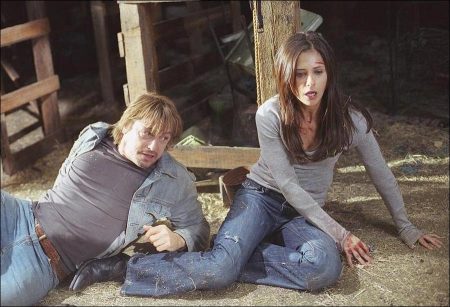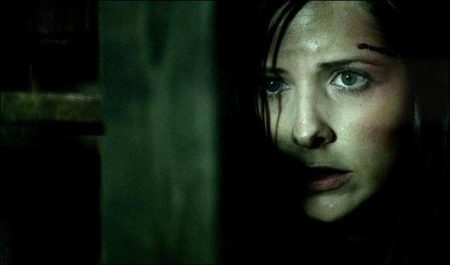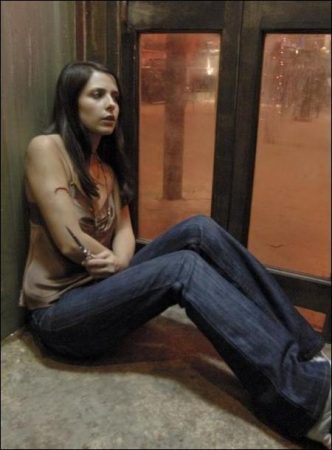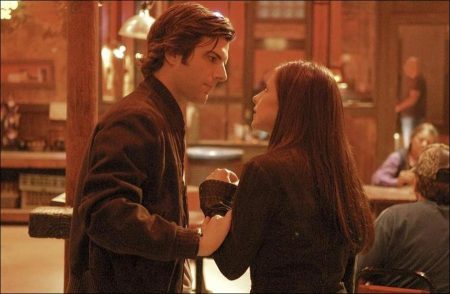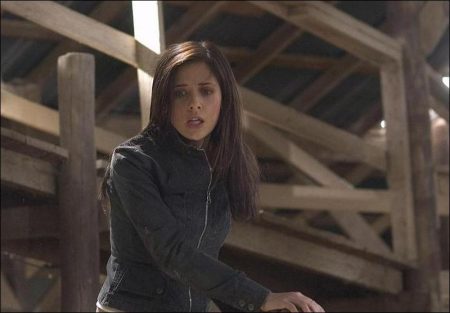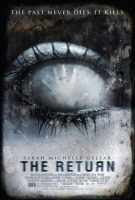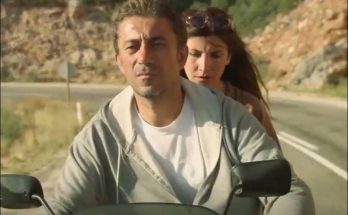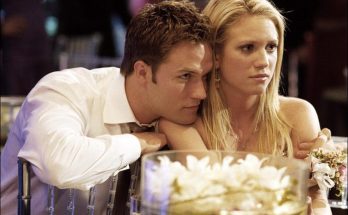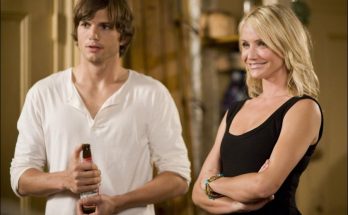Tagline: The past never dies. It kills.
A supernatural thriller starring Sarah Michelle Gellar as Joanna Mills, a tough young Midwesterner determined to learn the truth behind the increasingly terrifying supernatural visions that have been haunting her. Joanna has made a successful career for herself, as sales representative for a trucking company.
But her private life has been difficult; estranged from her father (Sam Shepard), stalked by an obsessed ex-boyfriend (Adam Scott), and with few friends, Joanna fears that she is losing control. She sees and feels the brutal murder of a young woman she’s never met, at the hands of a heartless killer – a man who appears to be making Joanna his next target. Determined to fight back, Joanna is guided by her nightmares to the murdered woman’s hometown. Once there, she will discover that some secrets can’t be buried; some spirits never die; and that the murder she is trying to solve may be her own.
The Return is a 2006 American horror thriller film directed by Asif Kapadia and starring Sarah Michelle Gellar, Kate Beahan, Peter O’Brien, and Sam Shepard. It was released theatrically on November 10, 2006, and on DVD on February 27, 2007.
Plot Description
In 2001 British director Asif Kapadia’s debut feature, The Warrior, a lyrical, beautiful movie set in the Himalayas, was named Best British Film at the BAFTA Awards. For his second film, Kapadia headed to Hollywood for the suspenseful horror flick The Return, written by first-time screenwriter Adam Sussman.
Sarah Michelle Gellar stars as Joanna Mills, an aggressive young woman who works as a successful saleswoman in the trucking industry. She pushes hard to go after a big deal in Texas, even though she had previously deemed the state off limits–something that happened to her when she was a little girl has kept her away from her hometown for many years.
Filled with fear, trepidation, and determination, she goes back to Texas, even visiting her estranged father (Sam Shepard). As she sees familiar places, she has frightening flashes of deja vu, remembering bits and pieces of a tragic incident involving an ex-con (Peter O’Brien), an unseen man, and a bad traffic accident. The visions haunt her dreams, sending her back to her childhood (where she’s played by Darrian McClanahan)
Reunited with an old friend (Kate Beahan), Joanna tries to move forward, but her unfinished past keeps dragging her back. Kapadia keeps things at a slow, suspenseful pace, every scene adding another piece of the plot–as well as a touch more mystery. Gellar, who has also starred in such horror films as The Grudge, I Know What You Did Last Summer, and Scream 2, plays Joanna with an involving sense of dread that is echoed by Dario Marianelli’s score.
About The Production
After a close friend endured a personal loss, screenwriter Adam Sussman felt that he “wanted to write something about the dead reconnecting with the living. Nothing was really clicking until I came across scientifically documented cases of very young children who had spontaneous memories of things and people and places that they could never possibly have known about.
“After doing more research and reading about the memories and stories that these children were accessing, I found that usually there was violence involved; a life had been cut short – and there was a reason for ‘the return.’”
Using these stories as a foundation, Sussman created the lead female character of Joanna Mills and then built a supernatural thriller storyline around her. “I enjoyed writing the scares, the big horror set pieces, and the – hopefully – surprising twists,” he says. “I set it in the Midwest because, although I’m from New York, I love the heartland – and because I thought remote locales would be scarier.”
Producer Aaron Ryder was immediately drawn to Sussman’s script. “I tend to gravitate towards movies that are a little more complicated than standard fare, and I hadn’t read anything quite like this before,” remarks Ryder. “The Return is a terrifying story about being haunted, in a ghostly manner, by things you don’t understand – and it’s a haunting story in a different way, because it’s also very much a love story of two soul mates trying to get back together. The complexity of the psychological thriller aspect also allows for an emotional core.
“I loved the idea of a powerful woman working in a man’s world, as well as the journey that Joanna presses ahead on, which is filled with intense visions and extraordinary situations. She has to learn who or what is trying to possess her, and why.”
Producer Jeffrey Silver adds, “She’s on a search – but for what, she doesn’t know. We did our research, but as filmmakers, the facts of specific cases were less important to us than what can be inside every human being. When we have the sense of déjà vu, what do we envision as the cause of it?”
Ryder remarks, “Adam did a lot of homework. I spoke with a gentleman who told me about just how you could wake up and sense another presence in your soul.
“Anticipation makes for a good thriller. The most terrifying aspect of The Return is the expectation that something awful is going to happen at the very next moment,” offers Silver. “This story is told with a serene surface point of view – but you’ll expect the worst to happen at any moment. That expectation permeates the landscapes in the movie.”
In 2004, director Asif Kapadia signed on to the project. The young British filmmaker’s first feature, The Warrior, had won praise all around the world, including two BAFTA Awards.
“The appeal of Adam’s script was the simplicity of it. The story is told more through imagery than dialogue. When we first met with Asif and talked about The Return, he said it would be about set undressing,” reveals Silver. “In terms of sets, costumes, acting, and dialogue, he wanted to generate the dramatic tension that a supernatural thriller requires with a spare quality to the presentation and imagery.”
Ryder confirms, “Asif a true storyteller, and is rather remarkable in his ability to pare away and shave down a story to its very essence, to its very core. There’s nothing superfluous in this movie. Orson Welles once said, ‘The absence of limitation is the enemy of art.’ It’s something Asif believes in. He likes to know what his parameters are, because then he can increase his creativity.
“As an emerging filmmaker, he has a strong vision and voice. He reminds me a lot of Christopher Nolan [with whom Ryder has made two films] in that regard, with the sensibility.”
The director responded to the screenplay’s “creepiness and suspense, and its series of layers. We unravel one, then another, then another…and you learn that everything has a motivation.”
Kapadia was also drawn to playing up the elements of fate and spirituality within the thriller framework. From his European perspective, “it was essentially a very American movie,” he admits. “But it had a sensual central idea of something spiritual, something otherworldly – which excited me; I felt this was something I could hook into.
“Different people – in different religions – have been brought up with the concept that people might die and come back in another life in another form.”
To tell Joanna’s story, Kapadia sought to create a specific interpretation. Accordingly, he says, “The point of view of The Return is that people are on some sort of path and that we’re not all separate beings. Somehow, there’s a force out there that links things up. You can try to come back to correct something that happened to you in another life.”
A few months after Kapadia began working with the producers and screenwriter, the casting process began in earnest once Ryder learned that Sarah Michelle Gellar had read the screenplay and responded positively to the material.
“Sarah has a huge and loyal fan base,” notes Ryder. “In The Return, they will be excited to see her really flexing her acting muscles. She’s playing a role that you haven’t seen her do before, and you’ll be seeing her in a different way. I think the complexities and seriousness of Joanna attracted her.”
Silver says, “In line with Asif’s approach, she really strips everything away and gets at Joanna’s basic motivations. Joanna undergoes a frightening psychological dissemblance, and Sarah took risks to play all that and to make the part her own. She’s done a marvelous job.”
Of her character, Gellar notes, “When we first meet her, she’s fairly lost; living her life, but not experiencing it. She had a rough childhood, ran away, took a job that she wasn’t necessarily passionate about but was good at – and allowed her to travel, so that she was never in one place long enough to worry about belonging. But things start happening, and she starts to deteriorate very quickly and goes on a frightening and passionate journey. She does violent things to her body; I spoke with people who have done what she does to herself, and we discussed the pleasure / pain principle. First comes pain, and then a euphoria.”
When Gellar first met with Kapadia, their conversation was more about concept than about the actual story. As Gellar relates, “I think we were both fascinated with its underlying Buddhist themes of life, that life is cyclical; you come and live your life and then you come back and fix the things from the past. The Return is about how you need to finish your life before you can truly transcend to what is the next life.”
“One of the things that I particularly liked about Joanna was that she speaks so well for everybody – young girls, middle-aged women – who understands what it’s like to not belong. She feels that she never did belong, that her place was never her own – and then finds out that these feelings are true. She takes action to find her identity and find where her place is.”
When Joanna’s journey mysteriously takes her to the town of La Salle, Gellar explains, “She starts having memories and feelings about a place she’s never been. She meets Terry and is drawn to him. Together, they find out what they have to offer each other and the ways they can help each other.”
“They’re two loners but there’s a powerful connection between them from when they meet, and they don’t know why,” says Sussman. “When they come together, they start to figure things out.”
The role of Terry called for an actor who could play a character at two disparate times in his life. In the present day, Terry is a 40-year-old who has seen too much after too many years in prison; in flashback sequences, he is in his 20s, and exudes a boyish romantic spark.
After an extensive casting search, Australian actor Peter O’Brien was tapped for his American film debut. Kapadia reports, “When Peter read for me, he just blew me away with his strength of character – and I love his look. I try to find actors who look the part and also have a weight, a presence. He takes his work seriously. Peter conveys that Terry has a past and been through a lot in his life.”
Gellar offers, “Peter liked and really understood the character, and was able to bring so much to playing him that was different than what an American actor would necessarily bring.”
“Sarah made it easy for me; she comes to the set prepared to work,” states O’Brien, who was drawn to The Return for several reasons. He says, “I had seen The Warrior and thought that Asif elicited honesty and truth from his characters and in his visuals. As far as Adam’s script, it delivered the unexpected; not just in the shocks and the twists and turns, but in subject matter and characters that are not conventional.
“I am drawn to play people who are quite dark and insular. Playing Terry was a challenge, because every time you see him he’s so contained – and because his development over the course of the movie is not sequential, so I had to forge links and maintain a sense of his character all the way through. He and Joanna are compelled to and are drawn to each other, and have to go on a journey together. The viewer will be encouraged to think deeper, about who these characters are and why they do what they do – and be unsettled by what they might do next.”
Another crucial player in the mystery of The Return is Joanna’s father, Ed Mills. Ryder notes, “They’ve been estranged for so many years that when circumstances bring them back together, conflicting feelings come to the surface.”
Silver adds, “There is a huge – 15-year – gulf between Joanna and Ed,” explains Silver. “In bridging that gulf, Joanna finds a clue in the mystery and is able to move on to the next step in her life.”
To play Ed, iconic playwright and actor Sam Shepard was always the first choice of Gellar and the filmmakers. Everyone was thrilled when Shepard responded positively to the story.
“I was told that he just felt the same connection to the script that everybody else had,” remembers Gellar. “I don’t think I’ve ever been so genuinely star-struck to work with someone.”
Kapadia admits, “I tried not to think too much about the fact that he’s a living legend – or else I couldn’t do my job properly. That’s what’s amazing about working in the U.S., to have the chance to work with someone like him.”
Rounding out the cast are two actors who the director felt consistently surprised by – for different reasons. He says, “J.C. Mackenzie, who plays Griff, occasionally terrified me during filming; I was literally cowering during some of his takes. Adam Scott plays Kurt, Joanna’s stalker ex, as not a clichéd violent guy, but as charming and even funny.”
“Several of our actors are playing against type,” notes Silver. “They made interesting choices.”
Even while casting was being finalized, Kapadia was already planning the movie’s visual scheme. He explains, “I’m pretty obsessive about making sure things look interesting and look right. For The Return, I wanted a dynamic, dramatic, and scary look.
“I’m a bit of an old-fashioned filmmaker in that I like to do things in-camera. Less is more, as far as I’m concerned. I wanted to create a subtle uneasiness and have the audience be scared and afraid, but in an original way. I’m a big fan of Polanski and Hitchcock – movies where there’s something that makes you feel uncomfortable but you’re not quite sure what it is – and there’s an element of Vertigo in the screenplay applying to Terry’s point of view, so I suppose I latched onto that.”
Gellar states, “I try to stay away from direct comparisons. Asif is unlike anybody else, and he’s not ripping off from this movie or stealing from that filmmaker. The ideas in The Return are original, and very much his own.”
To achieve the desired look, Kapadia recruited a key collaborator from The Warrior, cinematographer Roman Osin, to the project, and both worked closely with production designer Thérèse DePrez. The director explains, “To me, the visual side of a movie is an important part of the process. Our intention here was to slightly play with the mind and with time. The present-day portion of the story is meant to be more unsettling than the flashback portion. We have different looks for each period, but there are visual parallels we’re creating.
“Even when you’re in daylight, there is a lot of black in our frame. You won’t always see every corner of the image.”
The cinematic technique employs an almost constantly moving camera, one with many POV shots. Osin comments, “I utilize both hand-held and Steadicam for much of the film to enhance the unsettled feeling for the audience. With the many POVs, the camera sees Joanna’s all-too-lucid visions as she sees them – and it sees someone else’s visions, too.”
Gellar notes, “This was Asif and Roman’s first time working in America. So we had a different pace and they see things differently than our own tunnel vision.”
DePrez reports, “We spent time early on looking to set the mood and the feeling for this film. The most terrifying aspects of The Return are what you don’t see; the darkness and the not knowing what’s behind that wall, what’s lurking behind that corner. The anamorphic [2:35/1] ratio and the composition of the frame are so important to Asif and Roman, though there is never anything perfect about the frame. There are elements in the frame that are hidden in plain sight from the audience – and then revealed. Also, the film processing, in post-production, is being done in close to a ‘bleach bypass,’ which I don’t believe has previously been applied to a movie done in a rural setting.
“We tried to avoid clichés and hammering the audience over the head with imagery. There is a beautiful sparseness to this movie, where each element that is introduced into the composition is important graphically and will also convey something about the character in that space. We also tried to cultivate both the openness that exists in the Midwestern landscapes and a claustrophobic feeling for Joanna in select interiors.”
Kapadia, DePrez, and location manager Robbie Friedmann traveled a combined 3,000 miles and scouted 30 towns throughout Texas to find the right shooting locations. “Asif was very excited about coming here. Each town had such great character and history,” recalls DePrez. “Also, there is a certain palette and a certain quality of light in Texas that really doesn’t exist anywhere else; the way paint ages, the way things are colored, the Mexican influence – all very appropriate for our picture. You also have this very industrial rust that’s been completely overgrown with nature. There’s a beauty to it, but there’s also something frightening about it – especially if you don’t know it well, which Joanna doesn’t.”
Silver agrees, noting that the crux of the story was originally set to unfold elsewhere, but “we really thought the Texas landscape transposed beautifully to tell that same story. We wanted a terrain and a culture where Joanna has the constant sense of being off balance. The Texas landscapes have breadth and beauty and strangeness.”
The Return was shot on nearly two dozen locations. The Texas capital of Austin was chosen as the production base; a production office was set up at Austin Studios, which is under the auspices of the Austin Film Society.
The towns of Cele and Granger served as the primary locations for the fictional town of La Salle, Texas. On a property in Cele, a full-scale barn with weathered timbers was constructed as the centerpiece for the film’s climactic sequence, while the existing farmhouse was re-dressed and used for Terry’s home.
In Granger, the crucial Red Bar set was built in a dilapidated old cotton mill with a unique red brick structure “and a chimney sticking out of it,” marvels Kapadia. “Thérèse turned it into an amazing location.”
A few blocks away, DePrez’s team used an existing Slavic Union Hall as the set for Arlo’s Hotel. A hotel room was built on the second floor, situated at the end so there would be an eerie long hallway to cross.
“Being on the set and seeing the scenes come alive from the script I worked on for so long was – wild,” laughs Sussman.
Luling’s Cattle Auction Grounds served as a counterpart to the barn built in Cele. The two structures were kept architecturally similar so that the action-packed sequences that occur in both locations could better mirror each other, as called for in the story.
The historic town of Lockhart, Texas (just south of Austin) doubled for Wichita, Kansas; a 1930s Craftsman house was dressed as Joanna’s childhood home, where Ed still resides. When Joanna drives to visit Ed, the streets are Lockhart’s.
For a crucial car-crash scene, dams were built, sandbagging was implemented, and a river current was re-routed. “Stunts are never easy,” says Ryder. “But we crashed a car down a hillside, into a river creek – and it’s going to look great.”
The Return also filmed in the towns of Uhland and McNeil, at a power plant and nightclub in Austin, and on a stage at Austin Studios.
“Everyone has only good things to say about Austin, and I can see why,” adds Kapadia. “It has an amazing range of landscapes, wherever you go.”
Ryder states, “Basically, if you want to shoot a movie in the middle of the U.S., this is the best place to do so; great crew base, great locations…”
Silver marvels, “There’s a real film industry that’s been built up there.”
“Plus, Austin is a lot of fun,” emphasizes Ryder. “I swear, there are more bars there than in New York…”
“Austin is a great and happening city – I’m not sure if I’m actually cool enough to hang out there,” laughs Gellar. “We had a crew that had really worked together for five years already, so they were cohesive and had a shorthand. Because they were so incredibly efficient, it made it so much easier for the actors to step in.
“But we’re not the ones that have to drive to these faraway locations at night, and this crew worked so hard. They were amazing, and they all work together; if the cameraman needed help, the prop guy jumped in; if equipment needed to be moved, the craft service guy jumped in. Making movies is supposed to be a familial environment, with everybody pitching in, and I’d never seen that as much as I did on this shoot. This was one of the greatest crews I’ve ever been lucky enough to work with.”
Gellar reflects, “Asif found it all so magical; that rubbed off on everybody else. He brought European flair to this American story. Another thing I like about him is that he’s always right in the middle of it. Some directors will sit in their little tent in video village and yell out notes from there. But Asif is the one crouching in a corner underneath a black blanket, in the heat, so that, with nobody seeing him, he can be close enough to see an actor’s face – what they’re saying and what they’re not saying. I think it makes for a better performance.”
Kapadia reports, “I’ve never worked any other way; I like being next to the camera and being able to talk to the actors. If you’re looking at something on the monitor and there’s something going on in the corner, there’s no way you’re going to catch that – until it’s on a 50-foot screen. You also can’t always see the actors’ little details and expressions on a monitor, and that’s my job too.”
Silver comments, “I think the most challenging part of The Return was not our stunts – some of which were pretty big – but in creating on-screen an environment that is beautiful yet disturbing, serene yet unsettling.”
Kapadia says, “For me, probably the best part of directing is the shoot – whether it’s working with pyrotechnics or with just two actors playing off one another in a dramatic scene.”
O’Brien notes, “Asif has visual sense but also an understanding of the meat of the story. He’s knows what he wants, but he’s not one of those directors who’s rigid, as in ‘This is the shot’; you can approach him and contribute ideas.”
Gellar comments, “We worked at an incredibly rapid pace on a tight schedule, and shooting in these huge vast areas was not the normal hit-your-marks-and-say-your-dialogue; so often, we forget how much locations bring to a movie. Asif did some of the most complicated shots I’ve been a part of – and different than anything I’ve seen.”
Seeing the finished movie, DePrez says, “Audiences will experience the surprises of The Return with Joanna.”
O’Brien adds, “Human beings not behaving rationally is terrifying, and there are some unhinged and desperate people in our story. That’s the fear factor.”
Kapadia says, “I’m hoping we keep people on their toes while they’re watching this movie – and on a bit of a rollercoaster ride.”
The Return (2006)
Directed by: Asif Kapadia
Starring: Sarah Michelle Gellar, Kate Beahan, Peter O Brien, Adam Scott, Erinn Allison, Darrian McClanahan, Wally Welch, Brad Leland, Bonnie Gallup, Brent Smiga
Screenplay by: Adam Sussman
Production Design by: Thérèse DePrez
Cinematography by: Roman Osin
Film Editing by: Claire Simpson
Costume Design by: John Dunn
Set Decoration by: Jeanette Scott
Art Direction by: Steve Joyner, Jeff Knipp
Music by: Dario Marianelli
MPAA Rating: PG-13 for violence, terror and disturbing images.
Distributed by: Focus Features
Release Date: November 10, 2006
Visits: 126
